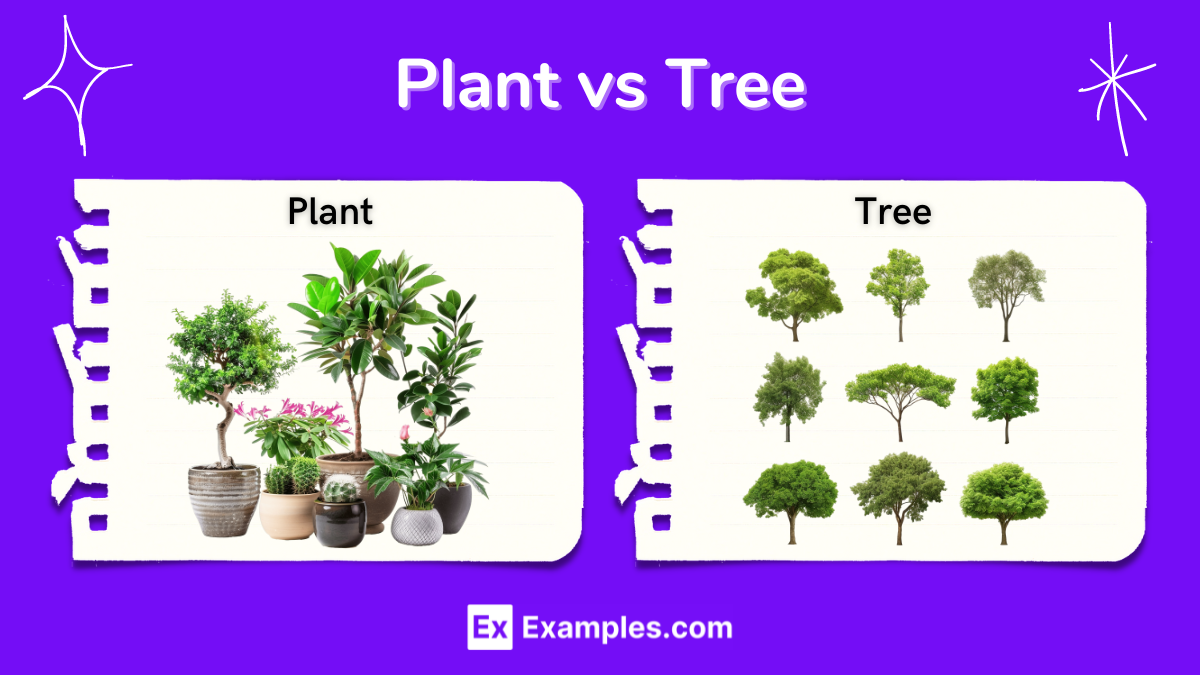What is the main difference between a plant and a tree?
Trees have leaves; plants do not
Trees are perennial and woody; plants may be annual or herbaceous
Trees grow in water; plants grow on land
Trees have flowers; plants do not


Plants and trees play crucial roles in Earth’s ecosystems, providing oxygen, food, and habitats for countless organisms. While both belong to the kingdom Plantae, they exhibit distinct characteristics and serve different functions in the environment. Understanding the differences between plants and trees helps us appreciate their unique contributions and importance. This article will explore the key differences, highlighting their structures, growth patterns, and ecological roles.
Plants encompass a diverse group of living organisms in the kingdom Plantae. They range from tiny mosses to large trees and thrive in various environments, from deserts to aquatic habitats. Here are the key features and functions of plants:
Trees are a specific type of plant characterized by their woody structure and perennial growth. They play vital roles in ecosystems and human life, providing numerous benefits. Here are the key features and functions of trees:

| Aspect | Plants | Trees |
|---|---|---|
| Definition | Encompasses a broad range of organisms in the kingdom Plantae, including flowers, shrubs, grasses, ferns, and mosses. | A specific type of plant characterized by a woody structure, including a trunk, branches, and a perennial growth pattern. |
| Structure | Can be herbaceous (non-woody) or woody. May include stems, leaves, and roots. | Always have a woody structure with a trunk, branches, and leaves. |
| Growth Pattern | Includes annuals, biennials, and perennials. Growth can be limited or indeterminate. | Typically perennial, with continuous growth in height and girth over many years. |
| Height | Varies widely from a few centimeters (like mosses) to several meters (like large shrubs). | Generally tall, often exceeding 3 meters, and can reach heights of over 100 meters. |
| Lifespan | Ranges from a single growing season to several years. | Long-lived, often surviving for decades to centuries. |
| Leaves | Varied in shape, size, and function. May be broad or needle-like. | Typically broad or needle-like, forming a canopy that performs photosynthesis. |
| Roots | Vary from shallow to deep, depending on the plant type. | Extensive root systems that anchor the tree and absorb water and nutrients. |
| Reproduction | Reproduces via seeds, spores, or asexual methods like cuttings and runners. | Primarily reproduces through seeds. Some can propagate vegetatively. |
| Examples | Sunflower, fern, cactus, grass, moss. | Oak, pine, mango, maple, cedar. |
| Ecological Role | Provides oxygen, food, and habitat for various organisms. Contributes to soil health and water cycle. | Provides significant carbon sequestration, habitat for wildlife, and stabilizes soil. |
| Economic Importance | Used in agriculture, horticulture, medicine, and landscaping. | Provides timber, fruits, nuts, resin, and other resources. Important for construction, paper, and food industries. |
| Climate Impact | Contributes to local climate regulation through transpiration and carbon absorption. | Major role in global climate regulation by sequestering carbon dioxide and influencing weather patterns. |
Trees are a type of plant characterized by a woody stem, while plants encompass all green, photosynthetic organisms including trees, shrubs, herbs, and grasses.
Yes, all trees are considered plants.
Trees and plants reproduce via seeds, spores, or vegetative methods like cuttings and runners.
Grass, shrubs, ferns, mosses, flowering plants, and trees.
Examples of trees include oak, pine, mango, maple, and cedar.
Yes, most plants, including trees, perform photosynthesis to convert sunlight into energy and produce oxygen.
Roots anchor plants and trees in the soil, absorb water and nutrients, and help prevent soil erosion.
Trees sequester carbon dioxide, produce oxygen, stabilize soil, provide habitats, and influence local climates through transpiration.
Yes, plants can be annual, biennial, or perennial, with varying lifespans and growth cycles.
Trees provide timber, fruits, nuts, and other resources essential for construction, food, and various industries, as well as ecological benefits.
Text prompt
Add Tone
10 Examples of Public speaking
20 Examples of Gas lighting
What is the main difference between a plant and a tree?
Trees have leaves; plants do not
Trees are perennial and woody; plants may be annual or herbaceous
Trees grow in water; plants grow on land
Trees have flowers; plants do not
Which of the following best describes the growth pattern of a tree?
Trees grow only above ground
Trees have a single trunk and grow in height
Trees do not have roots
Trees reproduce only through spores
Which category does a rose bush fall into?
Tree
Herbaceous plant
Woody shrub
Grass
How do trees generally differ from grasses in terms of structure?
Trees have vascular tissues; grasses do not
Trees have multiple stems; grasses have a single stem
Trees have a trunk and branches; grasses have leaves and stems
Trees grow in aquatic environments; grasses grow on land
What is a defining characteristic of most trees that is not typical of most plants?
They produce fruit
They have deep roots
They have a persistent woody trunk
They have broad leaves
Which of the following is an example of a non-woody plant?
Oak tree
Maple tree
Cactus
Fern
Which type of plant typically has a more extensive root system?
Trees
Grasses
Annual plants
Succulents
What type of plant structure do conifers, such as pines, have?
Herbaceous stems
Woody trunks and branches
Creeping vines
Floating leaves
How does the lifespan of most trees compare to that of annual plants?
Trees live for a shorter period than annual plants
Trees live for a longer period than annual plants
Trees and annual plants have similar lifespans
Trees do not have a defined lifespan
Which structure is commonly found in trees but not in most other plants?
Flowering parts
Woody trunk
Floating seeds
Tender leaves
Before you leave, take our quick quiz to enhance your learning!

